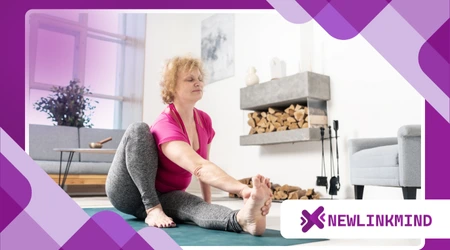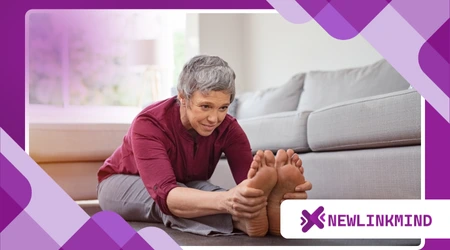How to Build a Home Yoga Practice as a Senior

Anúncios
Build a home yoga practice as a senior. As we navigate the rich tapestry of life, the golden years offer a unique opportunity for introspection and self-care.
It’s a time when many seek pathways to maintain vitality, sharpen mental acuity, and cultivate inner peace.
For seniors, the journey toward a more holistic lifestyle often leads to yoga. But what if studio visits are a challenge, or you simply prefer the comfort of your own space?
The good news is, you absolutely can build a home yoga practice as a senior, creating a sanctuary of wellness right where you are.
This guide will empower you to establish a consistent, beneficial yoga routine tailored to your unique needs, all within the familiar embrace of your home.
Anúncios
We’ll explore practical steps, mindful approaches, and inspiring insights to make yoga an integral part of your daily rhythm.
Why Yoga at Home is a Game-Changer for Seniors
Think of your home as a blank canvas, ready to be transformed into your personal wellness studio. This autonomy offers unparalleled benefits.
You dictate the pace, choose the time, and personalize every aspect of your practice. No travel time, no rush, just pure, unadulterated focus on your well-being.
Anúncios
This control fosters a deeper connection with your body and breath.
Beyond convenience, a home practice allows for intimate exploration.
You can experiment with poses, linger in stretches that feel particularly good, and truly listen to your body’s subtle cues. This self-discovery is invaluable, especially as we age.
Setting the Stage: Creating Your Sacred Space
A dedicated space, no matter how small, can profoundly impact your practice. It signals to your mind that this area is for calm and focus.
Consider a quiet corner, a sunlit spot, or even just clearing a patch in your living room. The key is consistency.
Read more: The Mental Health Benefits of Yoga for Seniors
Minimalism often works best. A yoga mat, perhaps a blanket for support, and maybe some soft lighting or a calming scent can set the mood.
This preparation primes your mind for the transition from daily activities to mindful movement.

Essential Props for Senior Home Yoga
While a mat is fundamental, certain props can significantly enhance safety and comfort.
Blocks, for example, bring the floor closer to you, aiding stability in standing poses. A strap can extend your reach, making stretches more accessible.
A bolster or a firm pillow can provide comfortable support for restorative poses, allowing for deeper relaxation.
Don’t underestimate the power of these simple tools; they are your allies in adapting poses to your body’s current capabilities.
Building Your Foundation: The Gentle Approach
Starting slowly is paramount. Think of your practice as a gentle stream, not a raging river.
Begin with shorter sessions, perhaps 15-20 minutes, gradually increasing duration as you gain strength and confidence. Consistency trumps intensity.
Focus on foundational poses that promote balance, flexibility, and strength without undue strain.
Chair yoga is an excellent starting point, offering support while you learn the movements. Remember, progress is a journey, not a race.
Crafting Your Routine: Structure and Flow
A structured routine provides comfort and predictability. Consider a warm-up, a series of standing or seated poses, and a cool-down with relaxation.
This framework creates a cohesive and fulfilling experience.
Read here: What Happens When Seniors Practice Yoga Daily?
Varying your routine keeps things fresh and engages different muscle groups. Perhaps one day focuses on gentle stretching, another on balance, and a third on restorative poses.
This adaptability ensures continued engagement.
The Breath Connection: Pranayama for Seniors
Breath, or pranayama, is the cornerstone of yoga. For seniors, conscious breathing can significantly improve lung capacity, reduce stress, and calm the nervous system.
Simple abdominal breathing is a powerful starting point.
Practice inhaling deeply, feeling your abdomen rise, and exhaling slowly, letting it fall.
This simple act can transform your practice and daily life, bringing a sense of grounded presence.
Mindful Movement: Listening to Your Body
Your body is your greatest teacher. Pay attention to sensations without judgment. If a pose causes discomfort, modify it or skip it.
Yoga is about honoring your body, not pushing it beyond its limits.
This mindful approach prevents injury and fosters a deeper connection to your physical self.
It’s about finding ease and comfort within each movement, even in challenging poses.
Overcoming Obstacles: Common Senior Challenges
Many seniors worry about flexibility or existing conditions. The beauty of yoga is its adaptability.
Poses can be modified for limited mobility, joint pain, or balance issues. Always consult your doctor before starting any new exercise regimen.
Remember, yoga isn’t about perfect poses; it’s about connecting breath with movement and cultivating inner peace. Your unique journey is valid and beautiful.
Staying Motivated: Inspiration for a Lasting Practice
Motivation can wane, but consistency builds habit. Celebrate small victories, whether it’s holding a balance pose a little longer or feeling more relaxed after a session.
These small successes fuel continued effort.
Consider journaling about your practice, noting how you feel before and after.
This self-reflection can provide powerful insights and reinforce the positive impact yoga has on your life.

Resources for Your Home Practice: Digital Age Allies
The digital landscape offers a wealth of resources for seniors looking to build a home yoga practice as a senior.
Online platforms provide a vast array of classes, from gentle chair yoga to restorative sessions, taught by experienced instructors.
Websites like Yoga with Adriene or Seniors Yoga offer free and subscription-based content tailored for various levels.
++ 5 Calming Mantras for Senior Meditation
Many platforms allow filtering by style, duration, and even specific conditions, making it easier to find practices that align with your needs.
This accessibility democratizes yoga, bringing it directly to your living room.
The Power of Community (Even at Home)
While practicing at home offers solitude, connecting with a wider yoga community can be incredibly enriching.
Online forums, social media groups, or even virtual meetups can provide support, encouragement, and a sense of belonging.
Sharing experiences and asking questions can deepen your understanding and commitment.
This virtual camaraderie ensures you never feel isolated on your yoga journey, fostering a sense of shared purpose and collective well-being.
After all, isn’t connection a fundamental human need, regardless of age?
Mary’s Journey
Consider Mary, a vibrant 78-year-old who initially felt intimidated by yoga studios. She decided to build a home yoga practice as a senior.
Starting with 10-minute chair yoga videos she found online, Mary gradually incorporated more standing poses using a wall for support.
Within six months, her balance improved remarkably, and she found herself sleeping more soundly. Mary’s dedication to her home practice transformed her daily life, proving that age is just a number when it comes to embracing new wellness routines.
Her doctor even noted her improved flexibility during a routine check-up.
The Analogy of a Garden
Think of building a home yoga practice as cultivating a garden. You prepare the soil (your dedicated space), plant the seeds (start with gentle poses), and consistently water and nurture them (regular practice and mindful breathing).
Some days, the sun shines brightly, and your garden flourishes effortlessly. Other days, you might encounter a few weeds (discomfort or lack of motivation) that need gentle tending.
But with patience and consistent effort, your garden (your yoga practice) will bloom, offering a continuous harvest of well-being, peace, and vitality.
A Glimpse into the Research
A study published in the Journal of the American Geriatrics Society in 2018 highlighted the significant benefits of yoga for older adults, showing improvements in balance, mobility, and a reduction in fall risk. This research underscores the scientific backing for incorporating yoga into a senior’s lifestyle, reinforcing its tangible positive effects on physical health and autonomy.
Embracing the Journey: Your Path to Lasting Well-being
Building a home yoga practice as a senior is more than just physical exercise; it’s an investment in your holistic well-being.
It’s about cultivating self-awareness, fostering resilience, and embracing the wisdom that comes with age. Each session offers an opportunity to reconnect with yourself, to find stillness in a busy world, and to move with grace and intention.
| Aspect of Well-being | Benefits of Home Yoga Practice for Seniors |
| Physical Health | Improved flexibility, balance, strength, reduced pain. |
| Mental Clarity | Enhanced focus, reduced anxiety, improved mood. |
| Emotional Balance | Stress reduction, increased self-compassion, inner peace. |
| Independence | Greater mobility, reduced fall risk, increased confidence. |
Your Mat, Your Sanctuary, Your Strength
Embarking on this journey to build a home yoga practice as a senior is a profound act of self-love.
It’s a commitment to nurturing your body, calming your mind, and uplifting your spirit. Remember, progress is personal and celebrated at every step.
Embrace the stillness, honor your body’s wisdom, and discover the profound transformation that awaits you within the sacred space of your own home.
Your mat is not just a piece of equipment; it’s a doorway to a more vibrant, balanced, and peaceful life.
Frequently Asked Questions
How often should a senior practice yoga at home?
Starting with 3-4 times a week for 15-20 minutes is excellent. Gradually increase duration and frequency as your body adapts and you feel more comfortable. Consistency is key.
What if I have joint pain? Can I still do yoga?
Absolutely! Many yoga poses can be modified to accommodate joint pain. Focus on gentle movements, use props for support, and avoid any poses that cause sharp pain.
Consult with your doctor or a physical therapist for personalized advice.
Do I need special equipment to start a home yoga practice?
Not necessarily. A yoga mat is highly recommended for comfort and grip. Blocks, straps, and blankets can be helpful but aren’t essential to begin. You can even use household items like sturdy chairs or pillows as substitutes.
How can I stay motivated to practice yoga at home alone?
Set realistic goals, celebrate small achievements, and make your practice enjoyable. Try different online classes or styles to keep things fresh. Consider a yoga journal to track your progress and reflections.
Is it safe to learn yoga solely from online videos without an in-person instructor?
For seniors, it’s generally safe to start with gentle online videos, especially those designed for older adults.
However, if you have specific health concerns or mobility limitations, an initial consultation with a certified yoga instructor who specializes in senior yoga can provide personalized guidance and ensure proper form.
